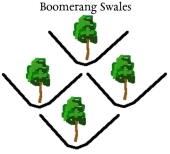
 3
3
















"Turn your face to the sun and the shadows fall behind you." ~Maori Proverb
www.permi-eden.com




Our projects:
in Portugal, sheltered terraces facing eastwards, high water table, uphill original forest of pines, oaks and chestnuts. 2000m2
in Iceland: converted flat lawn, compacted poor soil, cold, windy, humid climate, cold, short summer. 50m2








Moderator, Treatment Free Beekeepers group on Facebook.
https://www.facebook.com/groups/treatmentfreebeekeepers/









 2
2




People are the keystone species of the planet.




Darin Kirschbaum wrote:Beautiful and inspiring. I love seeing earthworks full of water after a rain, and in the desert even more so. Please post pictures/video of the rest of the site and let us know what's been going on there for the duration of the project. Was that an olive you were holding up?
People are the keystone species of the planet.




 1
1




George Meljon wrote:Neal, I admire your work. How deep are the aquifers there? When you state you have enough water from the rain to last 6 years, how is that possible?
People are the keystone species of the planet.




Subtropical desert (Köppen: BWh)
Elevation: 1090 ft Annual rainfall: 7"
 1
1




Jennifer Wadsworth wrote:Hi Neal:
I know a lot of people in drylands tend to plant trees "in" swales or infiltration basins as opposed to on either side (back cut or berm). Do you do this? Why or why not?
What other anti-evaporation methods do you employ?
People are the keystone species of the planet.

|
What's her name? You know. The fish girl. Ariel? She has a tiny ad.
The new gardening playing cards kickstarter is now live!
https://www.kickstarter.com/projects/paulwheaton/garden-cards
|







